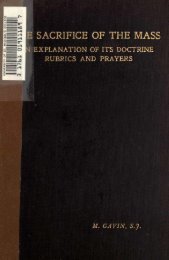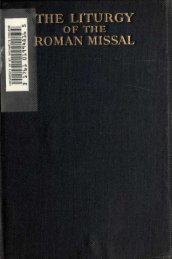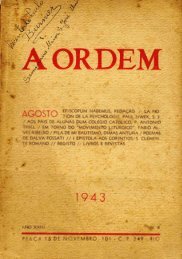E SACRIFICE OF THE MASS
E SACRIFICE OF THE MASS
E SACRIFICE OF THE MASS
You also want an ePaper? Increase the reach of your titles
YUMPU automatically turns print PDFs into web optimized ePapers that Google loves.
I 4<br />
<strong>THE</strong> CONSECRATION <strong>OF</strong> <strong>THE</strong> ALTAR.<br />
On the altar fixed, as on the altar-stone, five crosses<br />
are engraved, one at each corner and one in the<br />
centre.<br />
The altar is consecrated by a Bishop or by a priest<br />
specially delegated by the Pope.<br />
The most essential parts of the rite consist in the<br />
anointing with chrism (to indicate according to Gavantus<br />
the richness of grace) and the placing of relics in the<br />
sepulchre or aperture made in the altar-stone and<br />
afterwards filled up. (Catholic Dictionary, p. 23.)<br />
The Bishop makes five crosses on the altar-stone<br />
with his thumb, which he has dipped in a preparation<br />
of water, ashes, salt, and wine specially blessed.<br />
An essential part of the consecration is depositing<br />
merita sanctorum<br />
the relics of the martyrs in the altar : per<br />
tiiorum quorum veliquia hie sunt "by the merits of Thy<br />
saints whose relics are here" relics properly so called,<br />
that is, portions of the bodies of martyrs, not merely<br />
the clothes they wore, or things they possessed, must<br />
be buried in the altar. Relics of martyrs, not con<br />
fessors, are selected because there is a close connection<br />
between the martyr who dies for the faith and the<br />
Sacrifice of Calvary, where Christ, the King of Martyrs,<br />
shed His Blood for the Gospel which He taught, the<br />
faithful whom He redeemed, and the Church which He<br />
founded.<br />
During the Anglo-Saxon times, instead of the<br />
relics of martyrs, the Sacred Host was buried and<br />
enclosed in the sepulchre of the altar. The reason<br />
of this practice was perhaps the great difficulty of<br />
communicating with Rome in those days and in obtain<br />
ing portions of the saints bodies. (See Father Bridgets<br />
History of the Blessed Eucharist in Great Byitain.)






